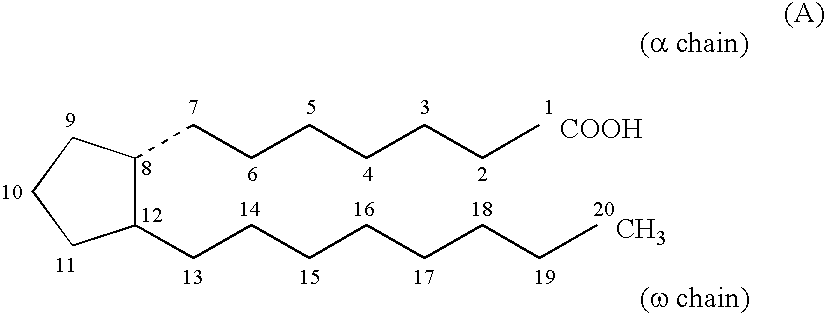Chloride channel opener
a chloride channel and chloride technology, applied in the field of chloride channel opening, can solve the problems of inability to know the action of prostaglandin compounds on chloride channels, intractable constipation, etc., and achieve the effects of reducing chloride ion permeability
- Summary
- Abstract
- Description
- Claims
- Application Information
AI Technical Summary
Benefits of technology
Problems solved by technology
Method used
Image
Examples
synthesis example 1
Preparation of 13,14-dihydro-15-keto-17-phenyl-18,19,20)-trinor-PGF2α N-ethylamide (5)
[0140]
(1)→(2)
[0141]3,4-dihydro-2H-pyran (0.70 ml, 7.67 mmol) was added to the solution of Compound (1)(0.350 g, 0.737 mmol) in anhydrous dichloromethane (10 ml). To the solution, camphor sulfonic acid (7 mg, 0.03 mmol) was added. The mixture was stirred for 30 min at room temperature. The reaction mixture was poured into saturated aqueous sodium bicarbonate and extracted with dichloromethane twice. The organic layer was dried over anhydrous magnesium sulfate and evaporated. Chromatography on a Silica gel column (BW-300 150 g, ethyl acetate:hexane=1:3) of the residue on evaporation gave Compound (2)(0.463 g, 0.720 mmol, 97.7% yield) as a colorless oil.
(2)→(3)
[0142]To the solution of Compound (2) (0.889 g, 1.38 mmol) in ethanol (14 ml), 1N-sodium hydroxide aqueous solution(6.9 ml, 6.9 mmol) was added. The reaction mixture was stirred for 16 hrs at room temperature. The mixture was cooled in ice-bath,...
synthesis example 2
Preparation of N1-ethyl-7-[(2,4aR,5R,7aR)-2-(1,1-difluoropentyl)-2-hydroxy-6-oxoperhydrocyclopenta[b]pyran-5-yl]heptanamide (7)
[0145]
Sub Lot-1
[0146]Carbonyldiimidazole (79. 5 mg, 0.490 mmol) was added to the solution of Compound (6) (174. 0 mg, 0.446 mmol) in anhydrous THF (5 ml). The mixture was stirred for 3 hrs at room temperature and then 2M-ethylamine in THF solution (0.87 ml, 1.74 mmol) was added to the mixture. The mixture was stirred for 12 hrs at room temperature. Saturated aqueous ammonium chloride (10 ml) and ethyl acetate (10 ml) were added to the reaction mixture with stirring. The aqueous layer was separated from the organic layer and extracted with ethyl acetate for 3 times. The combined organic layer was dried over magnesium sulfate and then evaporated. Chromatography on a Silica gel column (FL-60D 10 g, hexane:ethyl acetate=1:2) of the residue gave colorless oil (117.5 mg, 0. 281 mmol, 63.0% yield).
Sub-Lot2
[0147]Carbonyldiimidazole (105.9 mg, 0.653 mmol) was added t...
synthesis example 3
Preparation of N1-ethyl-7-[(2,4aR,5R,6S,7aR)-2-(1,1-difluoropentyl)-2,6-dihydroxyperhydrocyclopenta[b]pyran-5)-yl]heptanamide (15)
[0150]
(8)→(9)
[0151]3,4-dihydro-2H-pyran (4.22 ml, 46.11 mmol) and camphor sulfonic acid (42.16 mg, 0.181 mmol) were added to the solution of Compound (8)(2.87 g, 4.216 mmol) in anhydrous dichloromethane (90 ml) at 0° C. The reaction mixture was stirred for 50 min at 0° C. Saturated aqueous sodium bicarbonate was added to the reaction mixture. The mixture was warmed to room temperature and then extracted with dichloromethane (50 ml) for 3 times. The combined organic layer was washed with water (180 ml) and saturated aqueous sodium chloride (180 ml). The organic layer was dried over anhydrous magnesium sulfate and then evaporated. Chromatography on a Silica gel column (BW-300 154 g, hexane:ethyl acetate=8:1) of the residue gave Compound (9)(3.42 g, 4.476 mmol, quantitative yield).
(9)→(10)
[0152]1M-tetrabutylammonium fluoride in THF solution (5.371 ml, 5.371 ...
PUM
| Property | Measurement | Unit |
|---|---|---|
| temperature | aaaaa | aaaaa |
| temperature | aaaaa | aaaaa |
| temperature | aaaaa | aaaaa |
Abstract
Description
Claims
Application Information
 Login to View More
Login to View More - R&D
- Intellectual Property
- Life Sciences
- Materials
- Tech Scout
- Unparalleled Data Quality
- Higher Quality Content
- 60% Fewer Hallucinations
Browse by: Latest US Patents, China's latest patents, Technical Efficacy Thesaurus, Application Domain, Technology Topic, Popular Technical Reports.
© 2025 PatSnap. All rights reserved.Legal|Privacy policy|Modern Slavery Act Transparency Statement|Sitemap|About US| Contact US: help@patsnap.com



